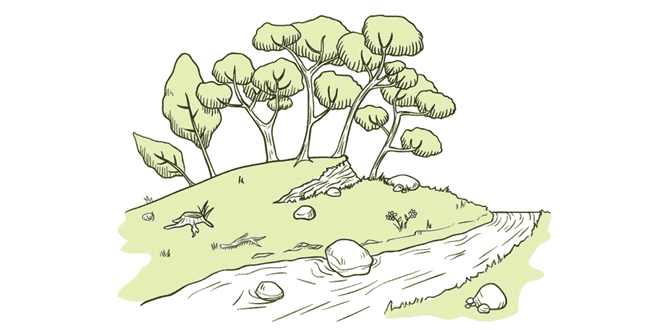Question: Discuss the significant difference between the Himalayan and the Peninsular rivers.
Answer: The Himalayan Rivers The Peninsular or Deccan Rivers
- The Himalayan rivers rise in the snow-covered mountains as such they flow throughout the year. The mountains in which the Deccan rivers rise are not snow-covered. Hence they dry up in summer.
- The Himalayan rivers flow in level-led Northern Plains. Therefore, they are quite useful for navigation and irrigation.The Peninsular rivers flow on uneven rocky surface. Therefore they are neither navigable nor useful for irrigation.
- The Himalayan rivers bring with them fertile alluvium which they deposit in the Indo-Gangetic Plains.The Peninsular rivers do not bring with them enough alluvium. As the current is swift so the deposition activity is negligible.
- Canals have been dug to use the water of these rivers for irrigation.As the terrain is rocky and the banks of these rivers are high, canals cannot be dug. However, dams are built to store the flood water for irrigation with the help of small channels.
- Many important towns and centers of trade are situated on the banks of these rivers. Very few important towns and centers of trade are situated on the banks of these rivers.
- The porous soil absorbs a lot of water, which is later on used as ground water by digging wells and tube-wells for domestic and irrigation purposes. The rocky soil does not absorb any water. Hence no wells can be dug. All the water flows down the sea at one and the same time.
Question: Compare the east flowing and the west flowing rivers of the Peninsular plateau.
Answer: East Flowing Rivers:
- The Mahanadi, the Godavari, the Krishna and the Kaveri are the main east flowing rivers of Peninsular India. These rivers drain in the Bay of Bengal. These rivers make deltas at their mouth.
West Flowing Rivers:
- These rivers have a developed tributary system. Their tributaries are comparatively large in size. These rivers flow through not very deep channels. The Narmada and the Tapi are the main west flowing rivers of Peninsular India. These rivers drain in the Arabian Sea. These rivers enter the sea through estuaries. These rivers are devoid of developed tributary system. Their tributaries are quite small in size. These rivers flow in a trough or a funnel like narrow but deep channels.
Question: State some economic benefits of rivers and lakes.
Answer:Economic benefits of rivers:
- Rivers have been a source of food since pre-history, almost all the civilizations developed along the river banks.
- Rivers are also used for irrigation, hydro-power generation.
- Rivers are used for navigation. They provide the cheapest inland means of transport.
- Water from the river is the basic natural resource essential for various day-to-day activities of human beings.
- It is also a rich source of fresh water fish.
Benefits of a Lake:
- A lake helps in preventing flood by regulating the flow of river.
- During dry seasons, a lake helps to maintain an even flow of the river.
- Lakes can also be used for generating hydro-power.
- Tourism development.
- Maintain aquatic ecosystem.
Question: Why are rivers important for the country’s economy?
Answer: Rivers have been of fundamental importance throughout human history. Water from the rivers is a basic natural resource, essential for various human activities. Therefore, the riverbanks have attracted settlers from ancient times. These settlements have now become big cities. Make a list of cities in your state, which are located on the bank of a river. Using rivers for irrigation, navigation, hydro-power generation is of special significance – particularly to a country like India, where agriculture is the major source of livelihood of the majority of its population.
 Class Notes NCERT Solutions for CBSE Students
Class Notes NCERT Solutions for CBSE Students





